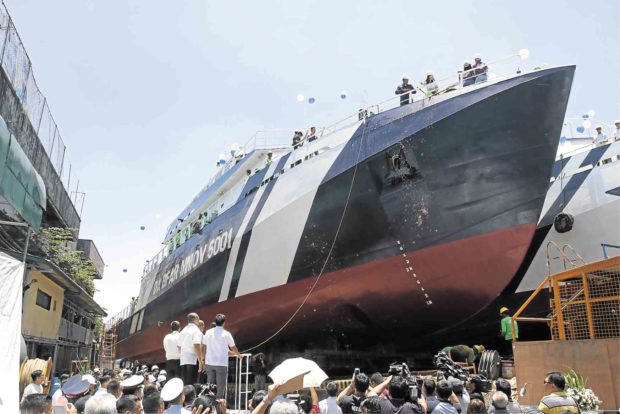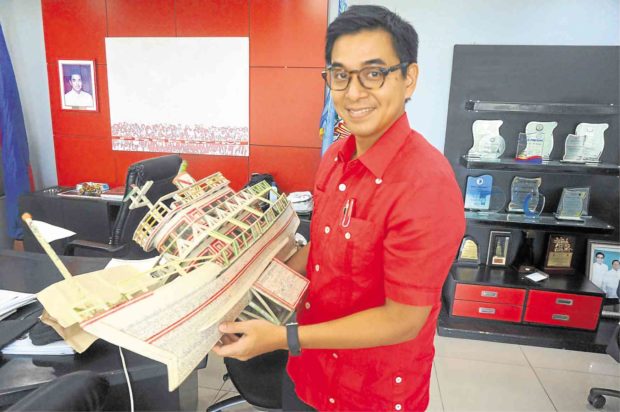Navotas-made ships to explore, protect PH waters

The two newly built MMOVs (multimission offshore vessels), one shown here during the Aug. 10 launch, will have a symbolic voyage in the West Philippine Sea, Philippine Rise and Sulu Sea.—PHOTO COURTESY OF NAVOTAS PUBLIC INFORMATION OFFICE
Lamberto Aguilar can still recall the day he started building his first fishing vessel in the 1960s.
“Almost all of the men in our community knew how to make ships. It was our primary source of income,” said the master carpenter.
Earlier this month, Aguilar and fellow shipyard workers in Navotas City saw how their homegrown industry, which started out by just assembling simple wooden boats for local livelihood, became capable of producing world-class seacraft intended for marine exploration and patrol.
“Proudly Navoteño-made” was how the city government described the MMOVs (multimission offshore vessels) Lapu-Lapu and Francisco Dagohoy, which were launched on Aug. 10 in Barangay San Roque.
The two 50.5-meter steel-hulled ships were ordered by the Bureau of Fisheries and Aquatic Resources (BFAR). Built by Josefa Slipways Inc., a medium-category shipyard, they were the first of their kind to be procured from a local company by the national government, which usually imports vessels from Japan, China and South Korea.
Article continues after this advertisementEach vessel costs P178.5 million, according to BFAR.
Article continues after this advertisement“The vessels will be used to protect Philippine waters against illegal fishing and for other purposes such as seaborne research activities and disaster relief or rescue operations,” City Hall said in a statement announcing the milestone.
Josefa Slipways started the construction of the BFAR vessels in January 2016. Both vessels are set to be commissioned in October and will have their symbolic voyage in West Philippine Sea, Philippine Rise and Sulu Sea, the statement added.

Mayor John Rey Tiangco, a former head of a local shipyard operators’ association, attests to the quality of the seacraft made by fellow Navoteños.—MARIEJO RAMOS
Fruit of ingenuity
“These vessels are the fruit of the ingenuity, resourcefulness and skills of Navoteños,” said Mayor John Rey Tiangco. “I have been to various shipbuilding and ship-repair conventions here and abroad when I was still head of the Metro Manila Shipyard Association Inc. (MMSAI). I am proud to say that the quality of the two new MMOVs are at par with those made in other countries.”
Richard Tulino, the current MMSAI chair, added: “The vessels launched for BFAR are world-class ships certified (for international voyage). They thought we couldn’t deliver, but this demonstrated the capability of Navotas shipbuilders to create high-quality ships.”
Considered the country’s fishing capital, Navotas, a city facing Manila Bay, currently hosts 31 companies that facilitate shipbuilding or ship repair and offer shipyard and dry-docking services. Each company employs about a hundred workers each.
In an interview, Tiangco traced the roots of the local shipbuilding industry to Capt. Luis Yangco, a businessman known as the “king of Manila Bay and the Pasig River,” who established the first dry-docking service in the city in 1880.
Families of fishermen soon began making their own boats, and small fleets eventually expanded and required shipyards, most of which can now be found along M. Naval Street.
The city government provides training for residents who wish to find work in the shipyards.
“Once they graduate, the association can hire and further train them,” said Tiangco.
Local incentive
Under a city ordinance, members of the association can also apply for tax incentives if they hire more Navoteños in their companies.
Producing the likes of a Lapu-Lapu and a Dagohoy was seen as a feat, especially given the challenges faced by the industry. Of the 45 registered shipbuilding companies across the country, 80 percent remain small-scale in operations and rely on raw materials mostly from China. This doubles the cost of every vessel produced.
“The challenge now is how to make the prices of our locally made ships more competitive. It’s really expensive here. Imagine, the country where you import materials is also your direct competitor. How would you compete?” said MMSAI president Louie De Dios.
Even operators of Ro-Ro (Roll-On, Roll-Off) ships would rather buy secondhand vessels from China at a lower price, he said.
Engineer Edward Cruz, an MMSAI member, also weighed in: “Look at China and Japan. They have emerged as developed countries because of shipbuilding, something we have failed to do because the industry lacks support from the national government.”
Aguilar, the 69-year-old carpenter, shared the sentiment. “Bakit ngayon lang nagawa ito? (Why did we achieve this only now?)” he wondered aloud, referring to the two BFAR-commissioned vessels.
Tatay Lamberto said he learned his skills from his father who worked as a carpenter during the pioneering years of Navotas shipbuilding. One of Aguilar’s three children is now also employed in a shipyard.
Labor issues
It usually takes 20 workers to finish a ship intended for domestic routes in six months, he said. But, unlike before when carpenters were on the frontline of construction, welders have taken over as companies make the shift to steel-hulled boats. Carpenters like him are now usually needed for repairs and restoration.
Like most contractual workers, Aguilar and his colleagues have to cope with lean periods. A fishing ban, for example, can leave them without work for months.
“We are surviving, but every now and then we can’t help but retrench some workers. Some Filipino shipbuilders, meanwhile, seek better opportunities abroad,” De Dios said. “Job security of our workers has become a problem because of the dwindling number of projects. We want to employ the best workers in town but how can we do that if we’re already burned by high construction costs?”
Tiangco stressed: “We need to work with other (shipbuilding) associations when it comes to financing. We can’t do it alone. But there’s also a challenge in terms of manpower. Filipino shipbuilders (working abroad) should be convinced to go back.”
The mayor and the MMSAI officials remained hopeful that the launch of the two MMOVs from Navotas would draw more attention to the need to further develop the shipbuilding industry as a backbone of national industrialization.
“People always ask us: Are we ready for this? And we tell them, yes, we are definitely ready,” De Dios said.